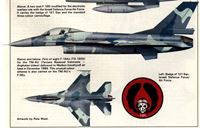Фотографии
-
Регистрационный номер: G-USTV, RN228 A fine example of a restored Second World War fighter is this Messerschmitt Bf 109G-2 which was rolled out at RAF Benson on 2 May 1991. ‘Luftwaffe’ enthusiasts will appreciate the accuracy of the markings which depict the original scheme of W.Nr. 10639 ‘Black 6’ of III/JG 77 when flying in support of Rommel's ‘Afrika Korps' in 1942. The overall scheme is ‘Sand Gelb (Temp) 79‘, with ‘Himmelblau 78’on the undersurfaces and fuselage sides. The first airworthy Gustav to be captured intact, the aircraft was shipped to the UK and given the RAF serial RN228 spending the rest of the war as part of No 1426 (Enemy Aircraft) Flight at Colleyweston. The aircraft will fly from Duxford for the next three years before retiring to the RAF Museum for permanent display.
Самолёты на фотографии: Messerschmitt Bf.109G - Германия - 1942
-
General Dynamics F-16C Fighting Falcon of the 52nd Tactical Fighter Wing based at Spangdahlem, Germany, in March 1989. The fin markings indicate the aircraft of the Wing's CO.
Самолёты на фотографии: General Dynamics F-16A/C/E Fighting Falcon - США - 1974
-
USAF F-16A ADF interceptor of the 194th FIS, Fresno ANG Base, Calif, 1990. Note the darker grey top surface colour compared with that of the F-16C.
Самолёты на фотографии: General Dynamics F-16A/C/E Fighting Falcon - США - 1974
-
Регистрационный номер: TS-16051 First of eight F-16As (TS-16051 for the TNI-AU (Tentara Nasional Indonesia - Angkatan Udara) delivered to Madiun-lswahyudi air base in December 1989. This unusual colour scheme is also carried on the TNI-AU's F-5Es.
Самолёты на фотографии: General Dynamics F-16A/C/E Fighting Falcon - США - 1974
-
A two-seat F-16D modified for the electronic warfare role with the Israeli Defence Force/Air Force. It carries the badge of 101 Sqn and the standard three-colour camouflage.
Самолёты на фотографии: General Dynamics F-16B/D Fighting Falcon - США - 1977
-
Регистрационный номер: AN523 Summer 1941 and AN523 takes-off from Polebrook’s recently-completed runway, guns in evidence in the nose, ventral and side positions. This particular Fortress, WP-D crash-landed at Roborough, Devon on 16 August 1941, following an attack on Brest and damage from attacking Bf 109s of JG 2.
Самолёты на фотографии: Boeing B-17 Flying Fortress - США - 1935
-
Регистрационный номер: AN526 Fortress I AN526 photographed before allocation to 90 Sqn. This aircraft became WP-G from 3 June 1941, survived its baptism of combat and ended its days as an instructional airframe. On the original print, the line of the undersurface (blue?) colour can be seen along the side of the nose and rear fuselage ending at the leading edge of the tailplane.
Самолёты на фотографии: Boeing B-17 Flying Fortress - США - 1935
Статьи
- -
- Airscene
- Fighter A to Z
- Flying colours
- In print
- Military Aircraft Directory (2)
- Talkback
- ??? - Ghana's Skyvans revived
- G.Jones - Crossair: Mature Teenager
- J.Fricker - Pakistan's Naval Air Power
- M.Spick - The Iron Tigers /Warbirds/
- R.Braybrook - The Kuwait Konflict. Nice one, Norm!
- R.Stitt - Turbo Firecat ... fighting flames with turbines
- S.Thompson - Tracker mods from Marsh






